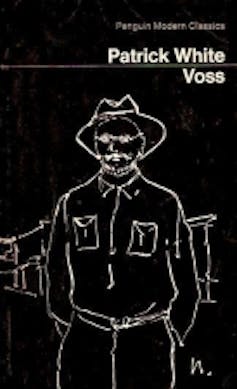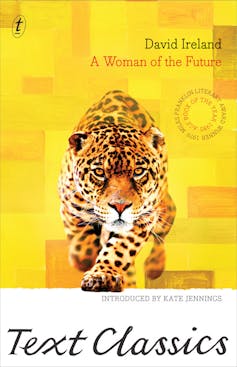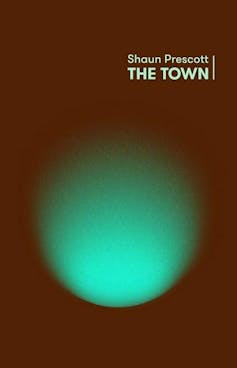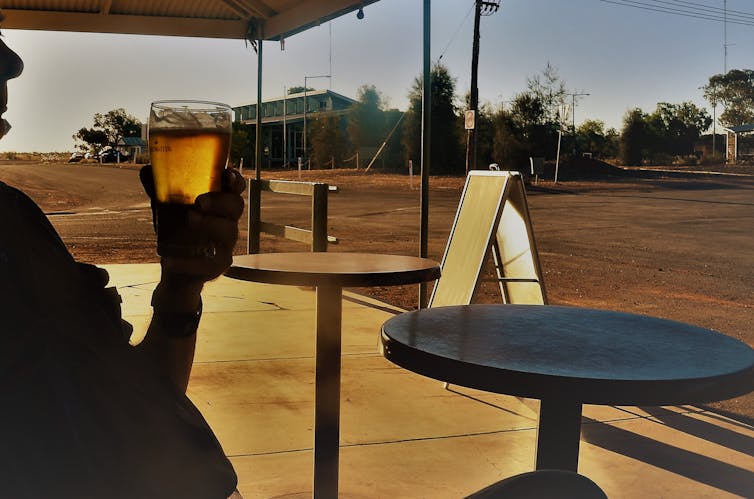Woke to the past, Shaun Prescott’s The Town moves beyond colonialism and then its protagonist
- Written by Bonny Cassidy, Lecturer in Creative Writing, RMIT University
Why do we tell stories, and how are they crafted? In this series, we unpick the work of the writer on both page and screen.
From Patrick White’s Voss to Tim Winton’s Breath, white, male Australian novelists have reproduced the hero character through sexualised conquests of other bodies and spaces.
To limited levels of success, debut novelist Shaun Prescott explores alternatives to this tradition in The Town.
Women and nature to conquer
 Voss, an anti-hero, virtually penetrates his immaculate lover, Laura, through telepathy; just as his journey into the “dead heart” of the country is both invasive and seemingly invisible.
Winton’s Pike looks back on a life defined by his own climactic physical drives towards the ocean and women. Despite rarely making sexual references, even Gerald Murnane’s narratives often employ traditional fantasies of women who, similar to his grassy horizons, are distant and mirage-like.
Though not without self-awareness, these stories repeat gendered male quests in which women and nature are analogous. They also reflect colonial visions of unpeopled landscapes for the taking.
Inspiring a new response
Written in the era of the Stella Count – a survey of newspapers, journals and magazines to gauge gender bias in Australian book reviews – Prescott’s The Town joins recent debuts by his peers, Jack Cox’s Dodge Rose (2016) and Tom Lee’s Coach Fitz (2018), in attempting to respond to a moment of intensified feminist and anti-colonial activism.
These novels follow the great renaissance of First Nations fiction led by Alexis Wright, Kim Scott and Melissa Lucashenko. They appear alongside culturally and sexually diverse settler stories by male authors like Omar Musa and Peter Polites. As a corollary to social change, the future of the white, heterosexual male character in Australian writing will undergo revision.
Murnane’s influence on The Town manifests in Prescott’s minute attention to Australian regionalism. It’s also there in Prescott’s reduction of that locality to abstractions, his narrator speculating:
If there’s a town in the countryside where I belong, it might already be hidden by some impenetrable shimmer.
Parochial dystopia
It’s David Ireland, though, who emerges as the most productive influence on Prescott. The latter may be continuing Ireland’s quite radical subversion of Australian gender images.
Voss, an anti-hero, virtually penetrates his immaculate lover, Laura, through telepathy; just as his journey into the “dead heart” of the country is both invasive and seemingly invisible.
Winton’s Pike looks back on a life defined by his own climactic physical drives towards the ocean and women. Despite rarely making sexual references, even Gerald Murnane’s narratives often employ traditional fantasies of women who, similar to his grassy horizons, are distant and mirage-like.
Though not without self-awareness, these stories repeat gendered male quests in which women and nature are analogous. They also reflect colonial visions of unpeopled landscapes for the taking.
Inspiring a new response
Written in the era of the Stella Count – a survey of newspapers, journals and magazines to gauge gender bias in Australian book reviews – Prescott’s The Town joins recent debuts by his peers, Jack Cox’s Dodge Rose (2016) and Tom Lee’s Coach Fitz (2018), in attempting to respond to a moment of intensified feminist and anti-colonial activism.
These novels follow the great renaissance of First Nations fiction led by Alexis Wright, Kim Scott and Melissa Lucashenko. They appear alongside culturally and sexually diverse settler stories by male authors like Omar Musa and Peter Polites. As a corollary to social change, the future of the white, heterosexual male character in Australian writing will undergo revision.
Murnane’s influence on The Town manifests in Prescott’s minute attention to Australian regionalism. It’s also there in Prescott’s reduction of that locality to abstractions, his narrator speculating:
If there’s a town in the countryside where I belong, it might already be hidden by some impenetrable shimmer.
Parochial dystopia
It’s David Ireland, though, who emerges as the most productive influence on Prescott. The latter may be continuing Ireland’s quite radical subversion of Australian gender images.
 woman of the future.
Ireland’s novels, including A Woman of the Future (1979) and City of Women (1981), probe the edges of realism and project into dystopian or surreal futures, just as Prescott does in The Town. Like Ireland, Prescott creates a magical realist world of parochial plausibility.
Prescott’s unnamed narrator is attempting to write a book on disappearing Australian towns, when the one he has chosen to research begins to dissolve into blank gaps and holes. This happens both metaphorically, as plazas and supermarkets take over town precincts, and literally as a source of mild terror. It’s all relayed with a bemused, laconic tone of narration:
The shops in the main streets were all closing. Dust set in thickly, brochures and mail littered stoops, and signs lost their colour beneath the gloom of rusted awnings. These losses did not register with the townspeople: they wandered the air-conditioned plazas, entering and exiting via escalators from dark undercover car parks.
Not driven by desire
Prescott ups the ante when it comes to plot. His narrator is searching for purpose. He has no outwardly directed sexual drive and where attraction looks like it could become a motivation, it proves a red herring.
woman of the future.
Ireland’s novels, including A Woman of the Future (1979) and City of Women (1981), probe the edges of realism and project into dystopian or surreal futures, just as Prescott does in The Town. Like Ireland, Prescott creates a magical realist world of parochial plausibility.
Prescott’s unnamed narrator is attempting to write a book on disappearing Australian towns, when the one he has chosen to research begins to dissolve into blank gaps and holes. This happens both metaphorically, as plazas and supermarkets take over town precincts, and literally as a source of mild terror. It’s all relayed with a bemused, laconic tone of narration:
The shops in the main streets were all closing. Dust set in thickly, brochures and mail littered stoops, and signs lost their colour beneath the gloom of rusted awnings. These losses did not register with the townspeople: they wandered the air-conditioned plazas, entering and exiting via escalators from dark undercover car parks.
Not driven by desire
Prescott ups the ante when it comes to plot. His narrator is searching for purpose. He has no outwardly directed sexual drive and where attraction looks like it could become a motivation, it proves a red herring.
 The narrator strikes up a rapport with his housemate’s girlfriend, Ciara, who becomes an ally. While she leaves her boyfriend and joins him on the road, the journey is neither romantic nor sexually tense. They are useful to one another. Her help makes the narrator feel “unqualified to speak”.
By reconstructing character conventions, Prescott flouts a heterosexual questing plot. Instead of sex, his narrator seeks food and drink, an austerely documented yet solo pastime.
Touching on the right to speak at the heart of anti-patriarchal and anti-colonial representations, the narrator’s cultural voice – his manuscript – peters out. A remnant sense of conservative responsibility compels him salvage what he can of the town’s disappearing culture. Ultimately, he comes to reject the goal as foolish and vain.
Alone in a crowd
The narrator ends up in Sydney, living in a car. Anonymity, incoherence and lost community define his experience of the city. Alone in the crowd, he observes an Anzac parade, a fleeting celebration of “unanimous sadness”. He concludes that collective cultural identity is a temporary truth. The man in the landscape, once silently independent, is now confused, homeless and deferential.
The narrator strikes up a rapport with his housemate’s girlfriend, Ciara, who becomes an ally. While she leaves her boyfriend and joins him on the road, the journey is neither romantic nor sexually tense. They are useful to one another. Her help makes the narrator feel “unqualified to speak”.
By reconstructing character conventions, Prescott flouts a heterosexual questing plot. Instead of sex, his narrator seeks food and drink, an austerely documented yet solo pastime.
Touching on the right to speak at the heart of anti-patriarchal and anti-colonial representations, the narrator’s cultural voice – his manuscript – peters out. A remnant sense of conservative responsibility compels him salvage what he can of the town’s disappearing culture. Ultimately, he comes to reject the goal as foolish and vain.
Alone in a crowd
The narrator ends up in Sydney, living in a car. Anonymity, incoherence and lost community define his experience of the city. Alone in the crowd, he observes an Anzac parade, a fleeting celebration of “unanimous sadness”. He concludes that collective cultural identity is a temporary truth. The man in the landscape, once silently independent, is now confused, homeless and deferential.
 The narrator ultimately gives up on documenting the demise of the town.
Shutterstock
This is where the frame of the novel buckles. Prescott’s narrator must speak – a lot, and to us – so he remains our interpreter of the world. While he relinquishes anthropological detachment, he also encourages himself to let go of the town as a subject to be recorded.
The novel’s protagonist exceeds its fictive device. This leaves Prescott in a tricky spot; The Town is, after all, the promised manuscript about disappearing towns. Prescott doesn’t scramble his protagonist’s world or morality as Ireland does, but ends the narration of his own cultural theory.
Structurally, The Town outstays its plot, becoming circular and monotonous. The narrative veil over Prescott’s own voice can feel like an unnecessary smokescreen when his ideas might, after all, have reached greater depths in the form of an essay.
To speak or not to speak; Prescott seems undecided. We watch as a white Australian male writes himself a marginal relationship to the continent.
The narrator ultimately gives up on documenting the demise of the town.
Shutterstock
This is where the frame of the novel buckles. Prescott’s narrator must speak – a lot, and to us – so he remains our interpreter of the world. While he relinquishes anthropological detachment, he also encourages himself to let go of the town as a subject to be recorded.
The novel’s protagonist exceeds its fictive device. This leaves Prescott in a tricky spot; The Town is, after all, the promised manuscript about disappearing towns. Prescott doesn’t scramble his protagonist’s world or morality as Ireland does, but ends the narration of his own cultural theory.
Structurally, The Town outstays its plot, becoming circular and monotonous. The narrative veil over Prescott’s own voice can feel like an unnecessary smokescreen when his ideas might, after all, have reached greater depths in the form of an essay.
To speak or not to speak; Prescott seems undecided. We watch as a white Australian male writes himself a marginal relationship to the continent.
Authors: Bonny Cassidy, Lecturer in Creative Writing, RMIT University





